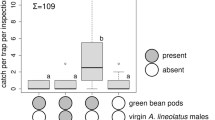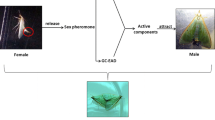Abstract
Females of the parasitic wasp Glyptapanteles flavicoxis (Hymenoptera: Braconidae) deposit a close-range sex pheromone from their abdominal tip that attracts conspecific males and elicits wing-fanning behavior. In this study, we isolated the pheromone components and determined their role in the males' behavior. In coupled gas chromatographic–electroantennographic detection (GC-EAD) analyses of the females' body extract, four components (below GC detection) elicited strong responses from male antennae. Monitored by GC-EAD, the components were separated by flash silica gel and high-performance liquid chromatography. Y-tube olfactometer experiments with one or more components revealed that all are necessary to elicit short-range attraction and wing-fanning responses by males. These components remained below detection threshold of the mass spectrometer (∼10 pg) even when 4500 female equivalents were analyzed in a single injection, which attests to the potency of the pheromone and the insects' sensitivity to it.






Similar content being viewed by others
References
Arn, H., Städler, E., and Rauscher, S. 1975. The electroantennographic detector—A selective and sensitive tool in the gas chromatographic analysis of insect pheromones. Z. Naturforsch. 30c:722–725.
Bell, R. A., Owens, C. D., Shapiro, M., and Tardif, J. R. 1981. Mass rearing and virus production, pp. 599–655, in C. C. Doane and M. L. McManus (eds.). The gypsy moth: Research toward integrated pest management. U.S. Dept. Agric. Tech. Bull. 1584, p. 757.
Bjostad, L. B., Jewett, D. K., and Brigham, D. L. 1996. Sex pheromone of caddisfly Hesperophylax occidentalis (Banks) (Trichoptera: Limnephilidae). J. Chem. Ecol. 22:103–121.
Boush, G. M. and Baerwald, R. J. 1967. Courtship behavior and evidence for a sex pheromone in the apple maggot parasite, Opius alloeus (Hymenoptera: Braconidae). Ann. Entomol. Soc. Am. 60:865–866.
Cole, L. R. 1970. Observations on the finding of mates by male Phaeogenes invisor and Apanteles medicaginis (Hymenoptera: Ichenumonidea). Anim. Behav. 18:184–189.
Corey, E. J. and Suggs, J. W. 1975. Pyridinium chlorochromate. An efficient reagent for oxidation of primary and secondary alcohols to carbonyl compounds. Tetrahedron Lett. 31:2647–2650.
Delury, N. C., Gries, G., Gries, R., Judd, G. J. R., and Brown, J. J. 1999. Sex pheromone of Ascogaster quadridentata, a parasitoid of Cydia pomonella. J. Chem. Ecol. 25:2229–2245.
Eller, F. J., Bartelt, R. J., Jones, R. L., and Kulman, H. M. 1984. Ethyl (Z)-9-hexadecenoate: A sex pheromone of Syndipnus rubiginosus, Hymenoptera, Ichneumonidae a sawfly parasitoid. J. Chem. Ecol. 10:291–300.
Fauvergue, X., Hopper, K. R., and Antolin, M. F. 1995. Mate finding via a trail sex pheromone by a parasitoid wasp. Proc. Natl. Acad. Sci. USA 92:900–904.
Field, S. A. and Keller, M. A. 1994. Localization of the female pheromone gland in Cotesia rubecula Marshall (Hymenoptera: Braconidae). J. Hymenopt. Res. 3:151–156.
Fuester, R. W., Taylor, P. B., and Groce, J. C. Jr. 1987. Reproductive response of Glyptapanteles flavicoxis (Hymenoptera: Braconidae) to various densities and instars of the gypsy moth, Lymantria dispar (Lepidoptera: Lymantriidae). Ann. Entomol. Soc. Am. 80:750–757.
Gries, R., Khaskin, G., Gries, G., Bennett, R. G., King, S. G. G., Morewood, P., Slessor, K. N., and Morewood, W. D. 2002. (Z,Z)-4,7-Tridecadien-(S)-2-yl acetate: Sex pheromone of Douglas-fir cone gall midge, Contarinia oregonensis. J. Chem. Ecol. 11:2283–2297.
Hu, C., Barbosa, P., and Martinat, P. 1986. Influence of rearing conditions on the survival and reproduction of Glyptapanteles flavicoxis (Marsh). J. Appl. Ent. 101:525–531.
Huwyler, S. 1972. Ultramikromethoden. Acetylierung von Alkoholen. Experientia 28:718–719.
Kainoh, Y. 1999. Parasitoids, pp. 383–404, in J. Hardie and A. K. Minks (eds.). Pheromones of Non-lepidopteran Insects Associated with Agricultural Plants, Oxford University Press, Oxford, p. 480.
Kainoh, Y., Nemoto, T., Shimizu, K., Tatsuki, S., Kusano, T., and Kuwahara, Y. 1991. Mating behavior of Ascogaster reticulatus Watanabe (Hymenoptera: Braconidae), an egg–larval parasitoid of the smaller tea tortrix, Adoxophyes sp. (Lepidoptera: Tortricidae). III. Identification of a sex pheromone. Appl. Entomol. Zool. 26:543–549.
Kamano, Y., Shimizu, K., Kainoh, Y., and Tatsuki, S. 1989. Mating behavior of Ascogaster reticulatus Watanabe (Hymenoptera: Braconidae), an egg–larval parasitoid of the smaller tea tortrix, Adoxophyes sp. (Lepidoptera: Tortricidae). II Behavioral sequence and a role of sex pheromone. Appl. Entomol. Zool. 24:372–378.
Kimani, S. W. and Overholt, W. A. 1995. Biosystematics of the Cotesia flavipes complex (Hymenoptera, Braconidae)—Interspecific hybridization, sex-pheromone and mating behavior studies. Bull. Entomol. Res. 85:379–386.
Krause, S. C., Fuester, R. W., and Burbutis, P. P. 1990. Competitive interactions between Cotesia melanoscelus and Glyptapanteles flavicoxis (Hymenoptera: Braconidae): Implications for biological control of gypsy moth (Lepidoptera: Lymantriidae). Environ. Entomol. 19:1543–1546.
Marchand, D. and McNeil, J. N. 2000. Effects of wind speed and atmospheric pressure on the mate searching behavior in the aphid parasitoid Aphidius nigripes (Hymenoptera: Aphidiidae). J. Insect Behav. 13:187–199.
Marsh, P. M. 1979. The braconid (Hymenoptera) parasites of the gypsy moth, Lymantria dispar (Lepidoptera: Lymantriidae). Ann. Entomol. Soc. Am. 72:794–810.
McNeil, J. N. and Brodeur, J. 1995. Pheromone-mediated mating in the aphid parasitoid, Aphidius nigripes (Hymenoptera: Aphididae). J. Chem. Ecol. 21:959–972.
Millar, J. G. and Haynes, F. K. 1998. Methods in Chemical Ecology, Vol. 1. Kluwer Academic Publishers, Dordrecht.
Nazzi, F., Powell, W., Wadhams, L. J., and Woodcock, C. M. 1996. Sex pheromone of aphid parasitoid Praon volucre (Hymenoptera, Braconidae). J. Chem. Ecol. 22:1169–1175.
Obara, M. and Kitano, H. 1974. Studies on the courtship behavior of Apalanteles glomeratus L. I. Experimental studies on releaser of wing-vibrating behavior in the male. Kontyu 42:208–214.
Pompanon, F., Deschepper, B., Mourer, Y., Fouillet, P., and Bouletreau, M. 1997. Evidence for a substrate-borne sex pheromone in the parasitoid wasp Trichogramma brassicae. J. Chem. Ecol. 23:1349–1360.
Quimio, G. M. and Walter, G. H. 2000. Swarming, delayed sexual maturation of males and mating behavior of Fopius arisanus (Sonan) (Hymenoptera: Braconidae). J. Insect Behav. 13:797–813.
Robacker, D. C. and Hendry, L. B. 1977. Neral and geranial: components of the sex pheromone of the parasitic wasp, Itoplectis conquisitor. J. Chem. Ecol. 3:563–577.
Shu, S. and Jones, R. L. 1993. Evidence for a multicomponent sex pheromone in Eriborus terebrans (Gravenhorst) (Hymenoptera: Ichneumonidae), a larval parasitoid of the European corn borer. J. Chem. Ecol. 19:2563–2576.
Sivinski, J. and Webb, J. C. 1989. Acoustic signals produced during courtship in Diachasmimorpha (= Biosteres) longicaudata (Hymenoptera: Braconidae) and other Braconidae. Ann. Entomol. Soc. Am. 82:116–120.
Staddon, B. W. and Everton, I. J. 1980. Haemolymph of the milkweed bug Oncopeltus fasciatus (Heteroptera; Lygaeidae): inorganic constituents and amino acids. Comp. Biochem. Physiol. 64A:371–374.
Stanley, G. 1979. Reaction gas chromatography in sealed glass capillaries. Dehydration, reduction and oxidation reactions, and the synthesis of reference compounds. J. Chromatogr. 178:487–493.
Swedenborg, P. D. and Jones, R. L. 1992a. Multicomponent sex pheromone in Macrocentrus grandii Goidanich (Hymenoptera: Braconidae). J. Chem. Ecol. 18:1901–1912.
Swedenborg, P. D. and Jones, R. L. 1992b. (Z)-4-Tridecenal, a pheromonally active air oxidation product from a series of (Z,Z)-9,13 dienes in Macrocentrus grandii Goidanich (Hymenoptera: Braconidae). J. Chem. Ecol. 18:1913–1931.
Swedenborg, P. D., Jones, R. L., Liu, H., and Krick, T. P. 1993. (3R,5S,6R)-3,5-Dimethyl-6-(methylethyl)-3,4,5,6-tetrahydropyran-2-one, a third sex pheromone component for Macrocentrus grandii Goidanich (Hymenoptera: Braconidae) and evidence for its utility at eclosion. J. Chem. Ecol. 19:485–502.
Syvertsen, T. C., Jackson, L. L., Blomquist, G. J., and Vinson, S. B. 1995. Alkadienes mediating courtship in the parasitoid Cardiochiles nigriceps (Hymenoptera: Braconidae). J. Chem. Ecol. 21:1971–1989.
Tagawa, J. 1977. Localization and histology of the female sex pheromone-producing gland in the parasitic wasp, Apanteles glomeratus. J. Insect Physiol. 23:49–56.
Tagawa, J. 1983. Female sex pheromone glands in the parasitic wasps, genus Apanteles. Appl. Entomol. Zool. 18:416–427.
Van den Dool, H. and Kratz, P. D. 1963. A generalization of the retention index system including linear temperature programmed gas–liquid partition chromatography. J. Chromatogr. 2:463–471.
Vinson, S. B. 1972. Courtship behavior and evidence for a sex pheromone in the parasitoid Campoletis sonorensis (Hymenoptera: Ichneumonidae). Environ. Entomol. 1:409–414.
Weseloh, R. M. 1976. Dufour's gland: source of sex pheromone in a hymenopterous parasitoid. Science 193:695–697.
Weseloh, R. M. 1980. Sex pheromone gland of the gypsy moth parasitoid, Apanteles melanoscelus: Revaluation and ultrastructural survey. Ann. Entomol. Soc. Am. 73:576–580.
Zar, J. H. 1996. Biostatistical Analysis. Prentice-Hall, Upper Saddle River, NJ.
Acknowledgments
We thank Carl Lowenberger for review of the manuscript, Susan Barth, Kenneth Swan, Philip Taylor, and Roger Fuester for supplying experimental insects, Bob Birtch for graphical illustrations, and two anonymous reviewers and Jeremy McNeil for constructive comments. This research was supported, in part, by a graduate fellowship from Simon Fraser University to A.D. and by a Discovery Grant and Industrial Research Chair from the Natural Sciences and Engineering Research Council of Canada (NSERC) to G.G., with Phero Tech. Inc., SC Johnson Canada, and Global Forest as industrial sponsors. Experimental insects were maintained in SFU's Global Forest Quarantine Facility, construction of which was completed through financial support from Global Forest (GF-18-2000-SFU-8).
Author information
Authors and Affiliations
Corresponding author
Rights and permissions
About this article
Cite this article
Danci, A., Gries, R., Schaefer, P.W. et al. Evidence for Four-Component Close-Range Sex Pheromone in the Parasitic Wasp Glyptapanteles flavicoxis . J Chem Ecol 32, 1539–1554 (2006). https://doi.org/10.1007/s10886-006-9068-1
Received:
Revised:
Accepted:
Published:
Issue Date:
DOI: https://doi.org/10.1007/s10886-006-9068-1




